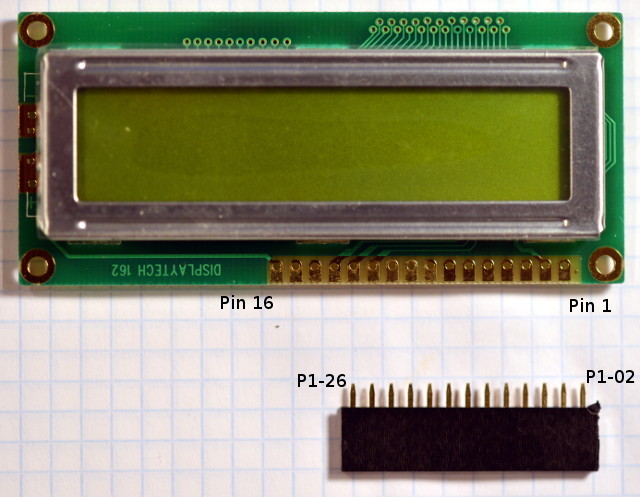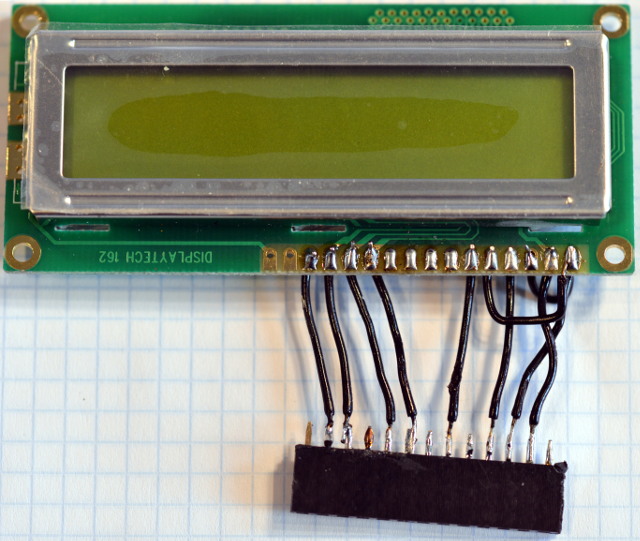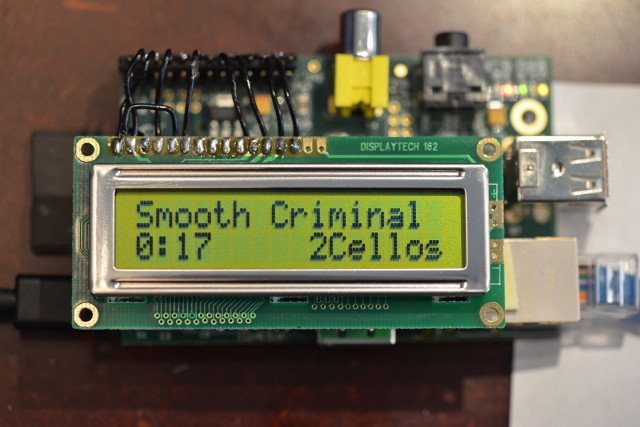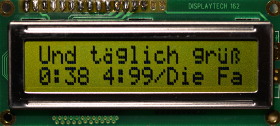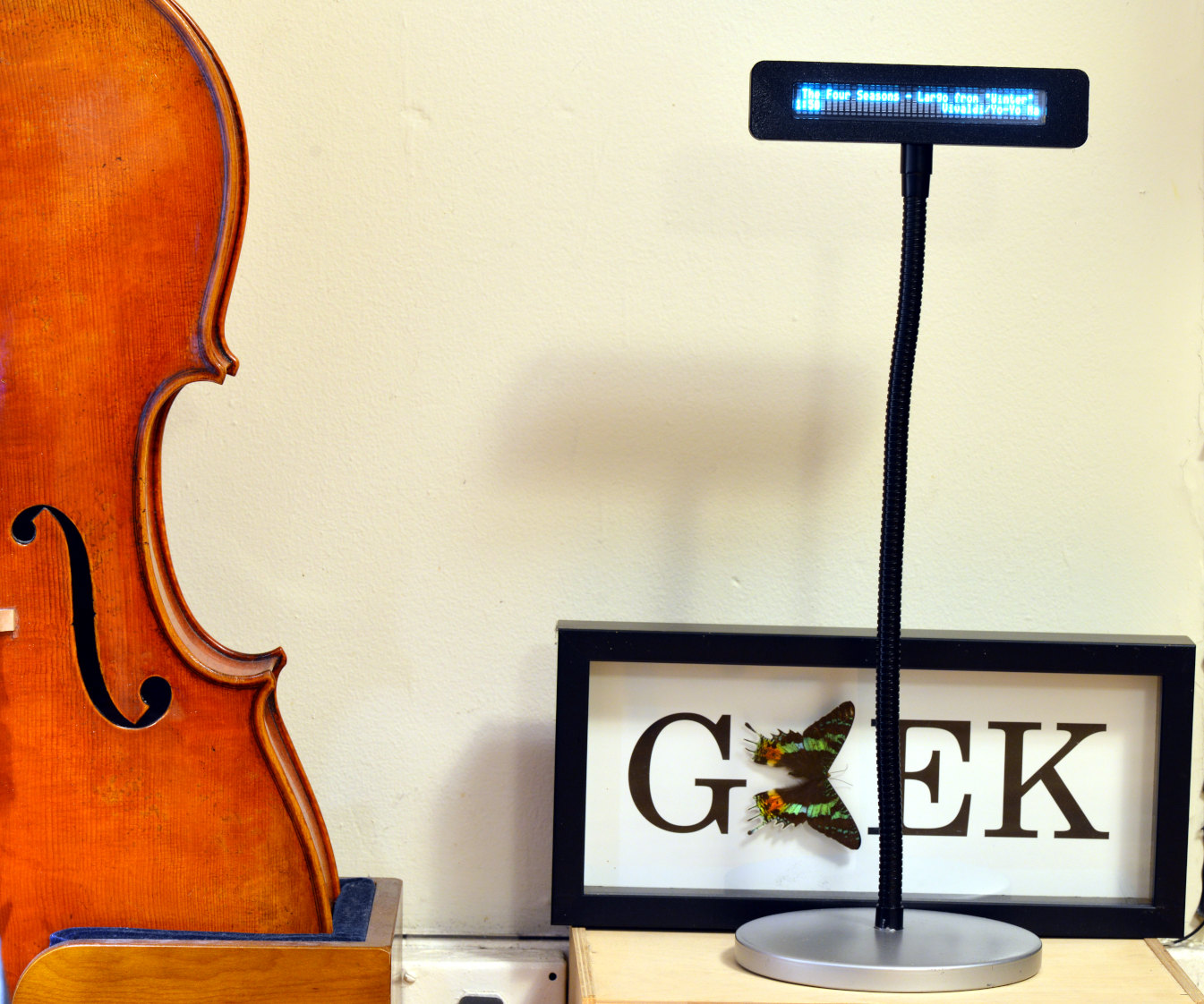This little program is a passive UPnP control point that connects to a UPnP/DNLA renderer (e.g. gmrender-resurrect) anywhere in your local network. It listens for changes in the state of the player (Title, Album etc., Play/Paused/Stop) and displays it on a common 16x2 LCD display or other HD44780 compatible displays.
First, we need to connect the LCD display to the Raspberry Pi. You need
- One 16x2 LCD display (HD44780 compatible; very common and cheap display, less than $3 on eBay)
- One female 13x1 header connector: one row with 13 contacts to plug into one row of the Raspberry Pi GPIO header.
- Cable and soldering iron (Of course, you can do it the breadboard way if you like)
First: identify the pins on the LCD display. They typically have 16 solder pins (sometimes 14 when they don't have a backlight). Pin 1 is usually closer to the edge of the board. Often marked with a '1' or a dot.
We want to connect them to the outer row of the GPIO connector, which are 13 pins (This sentence refers to the early Raspberry Pis that only had 26 pins; newer Pis have more, but the first pins are the same). The GPIO connector P1 has two rows, the pins are counted in zig-zag, so this means that we're connecting to the even pins (P1-02 .. P1-26, see http://elinux.org/RPi_Low-level_peripherals for reference).
If you put the Raspberry Pi in front of you, with the GPIO pins facing you, then P1-02 is to your right, P1-26 is to your left.
Connect
- LCD 1 (GND) to GPIO Pin P1-06 (3rd from right, GND)
- LCD 2 (+5V) to GPIO Pin P1-04 (2nd from right, +5V) Note, the first two wires are 'crossed'
- LCD 3 (contrast) to LCD 1 (GND) the contrast is controllable with a resistor, but connecting it to GND is just fine
- LCD 4 (RS) to GPIO Pin P1-08 (4th from right, Bit 14)
- LCD 5 (R/-W) to LCD 1 We only write to the display, so we set this pin to GND
- LCD 6 (Clock or Enable) to GPIO Pin P1-12 (6th from right, Bit 18)
- LCD 7 to LCD 10 are not connected
- LCD 11 (Data 4) to GPIO Pin P1-16 (8th from right, Bit 23)
- LCD 12 (Data 5) to GPIO Pin P1-18 (9th from right, Bit 24)
- LCD 13 (Data 6) to GPIO Pin P1-22 (11th from right, Bit 25)
- LCD 14 (Data 7) to GPIO Pin P1-24 (12th from right, Bit 8)
Cross check: With this connection, you should end up with the following configuration
- 8 wires connect LCD display with header.
- 2 wires connecting LCD pins to the first LCD pin (GND).
- Not connected LCD: Pin 7, 8, 9, 10 (and 15, 16 if it has these pins)
- Not connected RPi: GPIO P1-02, P1-10, P1-14, P1-20, P1-26 (seen from the right, this is pin 1, 5, 7, 10, 13).
I would suggest to first connect short cables to all LCD pins that need to be connected, then connect them right to left to the 13x1 header. The first two cables end up crossing over, all others are nicely sequenced.
Now, plug this into the outer row of your Raspberry Pi GPIO:
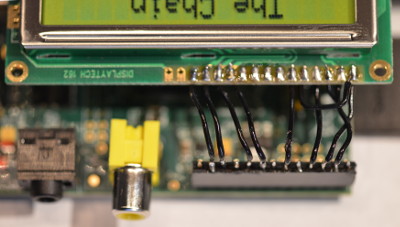
Here are the commands you need to execute on your Raspberry Pi shell.
First, you need to have libupnp installed (version >= 1.8)
sudo apt-get install libupnp-dev
Get the source. If this is your first time using git, you first need to install it:
sudo apt-get install git
.. Then check out the source:
git clone https://github.com/hzeller/upnp-display.git
Now change into the directory of the checked out source and simply compile it
with make:
cd upnp-display
make
sudo make install
Make sure you have not any services running that might interfere with the
GPIO pins. In particular you want to have the serial interface,
1-wire protocol and SPI disabled (use sudo raspi-config, then
choose "Interface Options").
Simple; for an LCD with width 16, start the program as such:
upnp-display -w 16
(Note, the program wants to run with realtime priority if possible to make sure the hardware timing talking to the LCD is correct. The program will print a message if you need to do something about that).
The LCD display should now print that it is waiting for any renderer; once it found a renderer, it will display the title/album playing.
If you have multiple renderers in your network, you can select a particular
one with the -n option:
upnp-display -n "Living Room"
Now, if you use your entertainment system the usual way, this display shows what currently is played. You can deploy this multiple times in the same network, so you can have one display in every room :)
Usage: ./upnp-display <options>
-n <name or "uuid:"<uuid>: Connect to this renderer.
-w <display-width> : Set display width.
-q : Quiet. Less log output
-c : Log LCD output on console instead
(does not need Raspberry Pi GPIO)
-C : Like above but fixed position.
(Best with -q: no logs interfere)
-s <timeout-seconds> : Screensave after this time.
-i <interface> : use this network interface.
-d : Run as daemon.
This should work with all renderers, that do proper eventing of variable changes. This program does not, at this time, actively query the renderer but expects it to transmit changes according to the UPnP eventing standard.
Right now, this is tested with gmrender-resurrect, which works perfectly.
These LCD displays only support the ASCII character set which is a bit limited for international titles or artist names.
Luckily, these displays have a way to have up to 8 user defined characters. We are using this feature to upload a font for characters outside the ASCII range (uses the excellent Public Domain fixed Unicode font maintained by Markus Kuhn).
This works of course only well if there are not more than 8 different non-ASCII characters on the screen - if you have song titles that are all outside this range (e.g. your language uses an entirely different script), then this is likely to fail.
Here you see an example that uses the non-ASCII characters ä, ü and ß
(If there is enough demand, I can separate out the unicode-aware display writing into a separate libray).
If you want to connect the display to some other computer than the Paspberry Pi, GPIO pins will be accessed differently. You have to change the hardware interfacing and modify lcd-display.cc
Most displays you can get are HD44780 compatible; There are as well
24x2 and 40x2 displays available (also pretty cheap). I found that 16
characters are a bit on the small side to display a useful amount without
scrolling constantly. If you get another display, use the -w option to choose
your width. Even if the pin-out looks a bit different (2 rows with 7 or 8
lines), they typically have the same data lines on the same pin numbers - check
your data sheet.
Here a 40 character display from ebay (DMC-50037N)
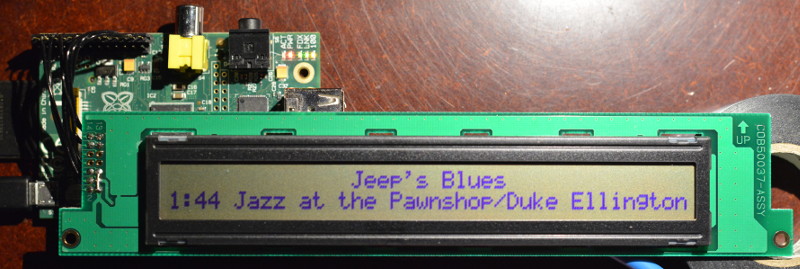
Newer Rasbperry Pi's, like this Raspberry Pi Zero W, are small enough to be mounted hidden behind the display and connecting wirelessly; here behind this gorgeous CU40025SCPB Noritake VFD:
| Front in 3D printed case | Back With Pi Zero W |
|---|---|
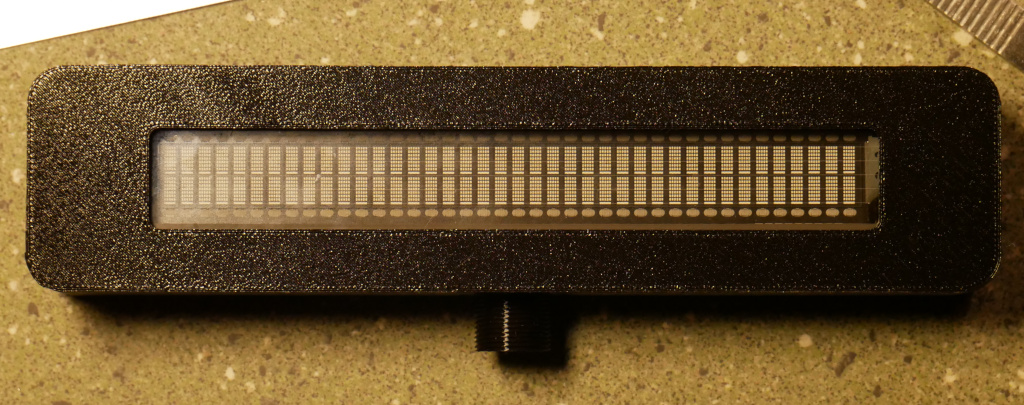 |
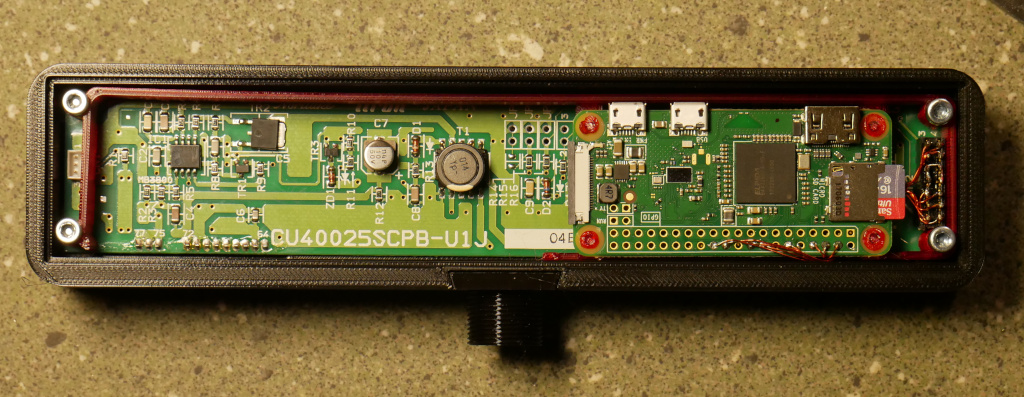 |
I am using this in this detached display built, mounted on a microphone gooseneck on an old Ikea lamp foot.
